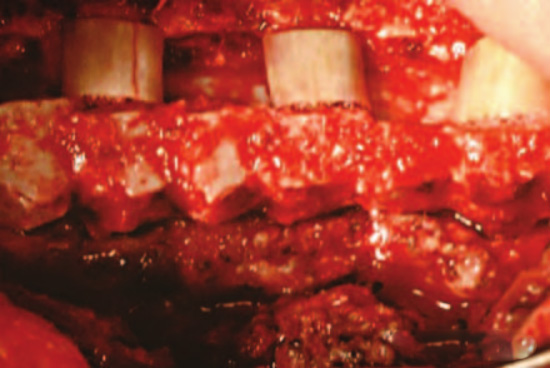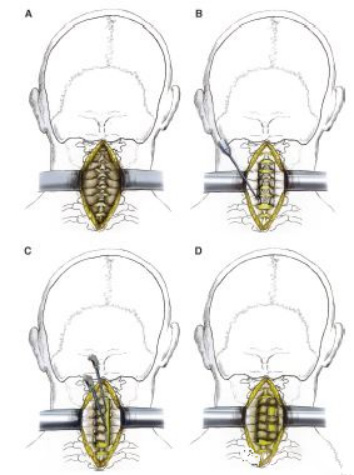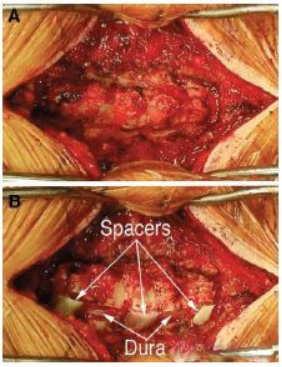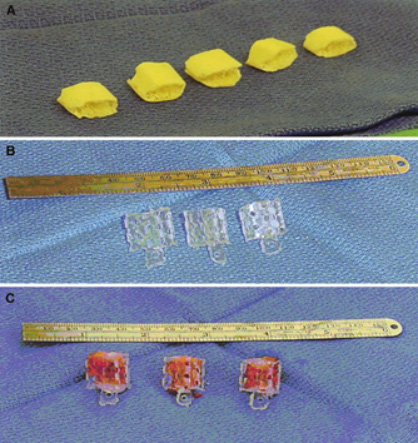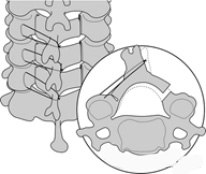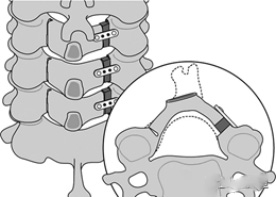نقطة رئيسية
1. التيار الكهربائي أحادي القطبيقوم السكين الثلاثي بقطع اللفافة ثم تقشير العضلة الموجودة أسفل الغشاء السمحاقي، مع الانتباه إلى حماية المفصل الزليلي المفصلي، وفي الوقت نفسه لا ينبغي إزالة الرباط الموجود في جذر العملية الشوكية من أجل الحفاظ على سلامة شريط التوتر العنقي؛
2. انتبهلزيادة فتح الباب بشكل تدريجي ككل، يمكن استخدام ملعقتين صغيرتين لفتح جزء صغير من إحدى اللوحات الفقرية ثم الأخرى، وهكذا بشكل متكرر، وفتحها تدريجيًا إلى العرض المثالي (يتم توسيع القناة الشوكية بمقدار 4 مم)، مما يمكن أن يتجنب الكسر الكامل للجانب المشقوق إلى أقصى حد ممكن؛
3. عند الفتحفتح الباب من جانب واحد، وقضم الرباط الأصفر في موقع الفتح قد يؤدي إلى نزيف من الضفيرة الوريدية، في هذا الوقت، لا داعي للذعر، يمكنك تطبيق التخثير الكهربائي ثنائي القطب لإيقاف النزيف، أو إسفنج الجيلاتين لإيقاف النزيف.
ابتكر علماء يابانيون جراحة العمود الفقري العنقي الخلفي ذات الباب المفتوح لأول مرة في سبعينيات القرن الماضي. ورغم تطورها بشكل كبير، إلا أن العملية الجراحية الأساسية لا تزال كما هي تقريبًا، وهي أكثر ملاءمة نسبيًا، وتشبه جراحة الباب الخلفي المزدوج ذات التأثير العلاجي المماثل، وهي من جراحات العمود الفقري العنقي الكلاسيكية لجراحي العمود الفقري.
1. عملية توسيع الصفيحة العنقية باستخدام الباب المفتوح
هذه المقالة من قسم جراحة الأعصاب في مستشفى جامعة ميامي في ميامي، فلوريدا، وفيما يتعلق بالاختيار المحدد للإجراء، فقد اختاروا إجراء الباب المفتوح من C3 إلى C7 لمعظم المرضى، مع وضع ضلوع الطعم المدعمة مفتوحة على موقع الباب المفتوح ومكملة بالغرسات الذاتية، كما هو موضح أدناه:
تم وضع المريض في وضعية الانبطاح، وتم تثبيت الرأس بإطار رأس مايفيلد، وتم استخدام الشريط لسحب كتف المريض لأسفل وتثبيته على سرير العمليات، وتم استخدام 1٪ ليدوكايين وأدرينالين للتسلل الموضعي ثم تم شق الجلد على طول خط الوسط للوصول إلى اللفافة، وتم تقشير العضلات من تحت السمحاق بعد شق اللفافة بسكين جراحي كهربائي أحادي المرحلة، وتم الاهتمام بحماية المفاصل الزليلية المفصلية، ويجب عدم استئصال رباط الجذر الوتدي من أجل الحفاظ على سلامة شريط التوتر للفقرات العنقية؛ تم عمل التعرضات العلوية والسفلية. وصلت نطاقات التعرض العلوية والسفلية إلى الجزء السفلي من الصفيحة الفقرية C2 والجزء العلوي من الصفيحة الفقرية T1، وتم إزالة الثلث السفلي من الصفيحة الفقرية C2 والثلث العلوي من الصفيحة الفقرية T1 باستخدام مثقاب طحن، ثم تم تنظيف الرباط الأصفر بواسطة ملقط عض الصفيحة مقاس 2 مم لفضح الأم الجافية، وتم عض جزء من النتوء الشوكي بواسطة ملقط عض للتحضير لزرع العظم.

بعد ذلك تم فتح باب C3-C7، كما هو موضح في الشكل أعلاه، وبشكل عام تم استخدام الجانب ذو الأعراض الأثقل كجانب لفتح الباب وتم استخدام الجانب الأخف كمفصلة، وكان موقع فتحة الباب أو التشقق في منطقة تقاطع اللوحة الفقرية والارتفاع المفصلي، وتم طحن جانب فتحة الباب من خلال القشرة بشكل ثنائي وتم طحن جانب المفصلة من خلال القشرة في طبقة واحدة، وتم استخدام رأس طحن ذو رأس متطابق لفتح الباب.
بعد طحن القشرة ثنائيا، يجب تنظيف الجانب المفتوح من الباب باستخدام الرباط الأصفر مع ملقط عض الصفيحة الفقرية حتى يمكن رؤية الكيس الجافية بوضوح، ثم استخدم ملعقة صغيرة لفتح "الباب" إلى حوالي 8-16 مم ووضعه في كتلة الزرع، مع الانتباه إلى الزيادة التدريجية في الحجم الإجمالي للباب المفتوح، ويمكن استخدام الملعقتين الصغيرتين لفتح صفيحة فقرية واحدة بمقدار صغير قبل فتح الأخرى، ثم تكرار العملية، ثم فتح الباب تدريجيًا إلى العرض المثالي (تتسع القناة بمقدار 4 مم)، وبهذه الطريقة، يمكن تجنب الكسر الكامل على جانب الفتحات إلى أقصى حد ممكن.
يجب أن يكون هناك وجود طفيف للضغط الانضغاطي في الموقع الذي يتم فيه وضع كتلة العظام دون الحاجة إلى تثبيت خارجي، وقد رأى المؤلفون عددًا قليلًا جدًا من المضاعفات في العيادة حيث تسقط كتلة العظام في القناة الشوكية، مع إزالة الزرع النهائي للعظم من العملية الشوكية على جانب المفصلة.
2. عملية توسيع الفقرات العنقية باستخدام تقنية الباب المفتوح
تحمل هذه المقالة، الصادرة عن قسم جراحة الأعصاب في المركز الطبي كيك بجامعة جنوب كاليفورنيا، نفس عنوان الوثيقة السابقة تقريبًا، مع تغيير في ترتيب الكلمات الإنجليزية، ودرجة عالية من الاتساق في منهجيتها وفلسفتها في العمل، وتعكس التوحيد في تدريب الجراحين في الولايات المتحدة.
تم إجراء الأجزاء الجراحية حصريًا تقريبًا من الفقرات C3-7 لتسهيل النزوح الخلفي للحبل الشوكي؛ وتم الحفاظ على أربطة الجذر الوتدي لتسهيل استقرار عنق الرحم؛ وتم استخدام مثقاب طحن برأس ثقاب لفتح الباب لتقليل الضرر الذي يلحق بالحبل الشوكي؛ وتم وضع كتل العظام في الفقرات C3 و5 و7 لدعم فتح الباب.
ملاحظة الشكل: أ، كشف الصفيحة من أسفل C2 إلى أعلى T1. ب، حفر الأخدود الجانبي مع قطع كامل للعظم على جانب واحد وقطع جزئي للعظم على الجانب الآخر. ج، رفع الصفيحة من C3 إلى C7 كوحدة واحدة. د، وضع فاصل عظمي متماثل.
ملاحظة الشكل: منظر أثناء العملية الجراحية بعد حفر ثقوب في الأخاديد الجانبية للفقرات C3 وC5 وC7 (أ) وبعد وضع فاصل ضلعي متماثل (ب).
ومع ذلك، فإن مادة طُعم العظم، بالإضافة إلى العظم الخيفي (الشكل أ)، هي طُعم عظمي فقري ذاتي المنشأ مصنوع من شبكة حمض البولي لاكتيك، كما هو موضح أدناه (الشكل BC)، وهو أقل شيوعًا في الصين. أما عرض فتحة الباب، فيُعتبر العرض الأمثل 10-15 مم، وهو يختلف قليلاً عن العرض المذكور أعلاه والذي يتراوح بين 8-16 مم.
عند إجراء فتح باب واحد للصفيحة الفقرية، قد يؤدي قضم الرباط الأصفر في موقع فتح الباب إلى نزيف من الوريد، في هذا الوقت لا داعي للذعر، يمكنك تطبيق التخثير الكهربائي ثنائي القطب لإيقاف النزيف أو إسفنجة الجيلاتين لإيقاف النزيف.
3. عملية تضييق عنق الرحم
بالإضافة إلى دعم كتلة العظام عند فتحة الباب، تم وصف طرق أخرى لتثبيت فتحة الباب في هذه المقالة، مثل طريقة السلك الرابط وطريقة التثبيت بالصفائح الدقيقة، والتي تُستخدم الأخيرة حاليًا بشكل أكثر شيوعًا في الممارسة السريرية وتوفر تثبيتًا آمنًا.
مرجع
1. إليزابيث الخامسة، شيث RN، ليفي AD . Oتوسيع الفقرات العنقية باستخدام قلم الباب [J]. جراحة الأعصاب (ملحق 1):ملحق 1.
[PMID:17204878؛https://www.ncbi.nlm./pubmed/17204878]
2. وانغ ماي، غرين بي إيه. أوبتوسعة الصفيحة الفقرية العنقية من خلال الباب n [J]. جراحة الأعصاب (1): 1.
[PMID:14683548؛https://www.ncbi.nlm./pubmed/14683548 ]
3. شتاينميتز، عضو البرلمان، ريسنيك، د.ك.استئصال الصفيحة الفقرية [J]. مجلة العمود الفقري، 2006، 6(6 ملحق): 274S-281S.
[PMID:17097547؛https://www.ncbi.nlm./pubmed/17097547]
وقت النشر: ٢٧ فبراير ٢٠٢٤






